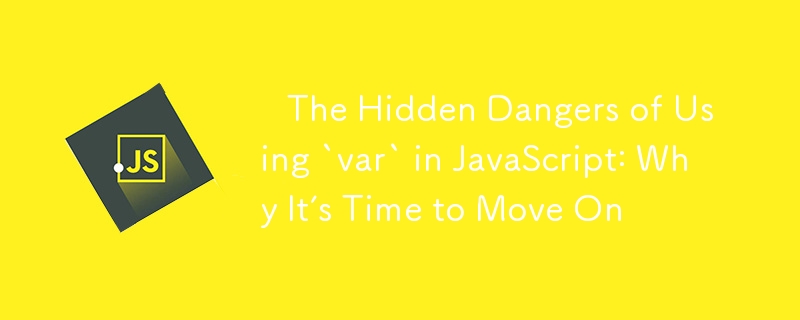

The keyword var has been the default way to declare variables in JavaScript for many years. However, it has several quirks and pitfalls that can lead to unexpected behavior in your code. Modern alternatives like let and const solve many of these problems, making them the preferred choice for declaring variables in most cases.
? Explanation:
In JavaScript, var declarations are hoisted to the top of their scope, meaning they’re initialized as undefined even if the declaration appears later in the code. This can cause confusing behavior and lead to bugs that are hard to detect.
? Key Points:
? Example:
console.log(myVar); // undefined (hoisted but not initialized) var myVar = 10; console.log(myVar); // 10
? Comment: The variable myVar is hoisted to the top of the scope but is initially undefined, which can cause confusion in your code.
? Fix:
? Example Fix:
console.log(myLet); // ReferenceError: myLet is not defined let myLet = 10; console.log(myLet); // 10
? Comment: Using let prevents the variable from being accessed before it is declared, reducing confusion and potential bugs.
? Explanation:
One of the major flaws of var is that it is function-scoped, not block-scoped. This means that variables declared inside loops, if statements, or other blocks are not confined to that block, but can be accessed outside it, which can lead to bugs.
? Key Points:
? Example:
if (true) {
var blockVar = "I’m accessible outside this block";
}
console.log(blockVar); // "I’m accessible outside this block"
? Comment: Although blockVar was declared inside the if block, it is still accessible outside the block because var is function-scoped, not block-scoped.
? Fix:
? Example Fix:
if (true) {
let blockLet = "I’m only accessible inside this block";
}
console.log(blockLet); // ReferenceError: blockLet is not defined
? Comment: Using let or const ensures that variables remain confined to their respective blocks, preventing scope leakage.
? Explanation:
With var, you can accidentally redeclare the same variable in the same scope, which can overwrite the previous value. This can lead to unintentional bugs, especially in larger codebases where variable names might be reused by mistake.
? Key Points:
? Example:
var name = "Alice"; var name = "Bob"; // No error, overwrites the previous value console.log(name); // "Bob"
? Comment: The second declaration of name overwrites the first one, potentially causing bugs in the code.
? Fix:
? Example Fix:
let name = "Alice"; let name = "Bob"; // SyntaxError: Identifier 'name' has already been declared
? Comment: Using let or const helps you avoid redeclaring variables and ensures that your code remains predictable.
? Explanation:
When using var in loops, the variable’s value can change in unexpected ways, especially when working with asynchronous code. Since var is function-scoped and not block-scoped, the loop variable might hold an unexpected value when accessed inside asynchronous callbacks.
? Key Points:
? Example:
for (var i = 0; i < 3; i++) {
setTimeout(() => console.log(i), 1000); // Prints: 3, 3, 3 (unexpected)
}
? Comment: Because var is not block-scoped, the loop variable i is shared across all iterations, and its final value (3) is used in each setTimeout callback.
? Fix:
? Example Fix:
for (let i = 0; i < 3; i++) {
setTimeout(() => console.log(i), 1000); // Prints: 0, 1, 2 (as expected)
}
? Comment: Using let creates a new instance of i for each iteration, fixing the asynchronous callback issue and ensuring the correct values are printed.
? Explanation:
Closures can lead to unexpected behavior when combined with var. Since var is function-scoped, its value might change in ways that are not expected when a closure captures it.
? Key Points:
? Example:
function createFunctions() {
var funcs = [];
for (var i = 0; i < 3; i++) {
funcs.push(function() {
console.log(i);
});
}
return funcs;
}
var myFuncs = createFunctions();
myFuncs[0](); // 3 (unexpected)
myFuncs[1](); // 3 (unexpected)
myFuncs[2](); // 3 (unexpected)
? Comment: All closures are capturing the same i value because var is function-scoped, leading to unexpected results.
? Fix:
? Example Fix:
function createFunctions() {
var funcs = [];
for (let i = 0; i < 3; i++) {
funcs.push(function() {
console.log(i);
});
}
return funcs;
}
var myFuncs = createFunctions();
myFuncs[0](); // 0
myFuncs[1](); // 1
myFuncs[2](); // 2
? Comment: With let, each closure gets its own copy of i, fixing the issue and ensuring the expected values are printed.
While var was the original way to declare variables in JavaScript, it has several shortcomings that make it a poor choice in modern JavaScript development. The introduction of let and const provides better scoping, reduces the risk of bugs, and makes your code more predictable. To write cleaner and more maintainable JavaScript, it's time to move on from var and embrace let and const.
The above is the detailed content of ⚠️ The Hidden Dangers of Using `var` in JavaScript: Why It's Time to Move On. For more information, please follow other related articles on the PHP Chinese website!
 Common Linux download and installation tools
Common Linux download and installation tools
 CSS scroll bar style
CSS scroll bar style
 switch statement usage
switch statement usage
 The role of php probe
The role of php probe
 How to read macro control data in javascript
How to read macro control data in javascript
 mysql engine introduction
mysql engine introduction
 How to solve the problem that js code cannot run after formatting
How to solve the problem that js code cannot run after formatting
 There is an extra blank page in Word and I cannot delete it.
There is an extra blank page in Word and I cannot delete it.




